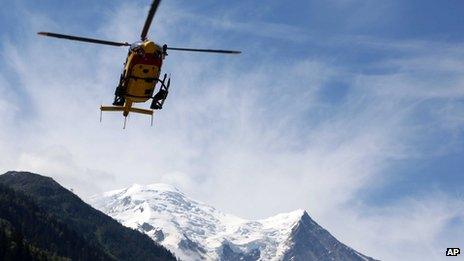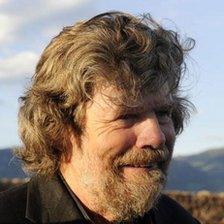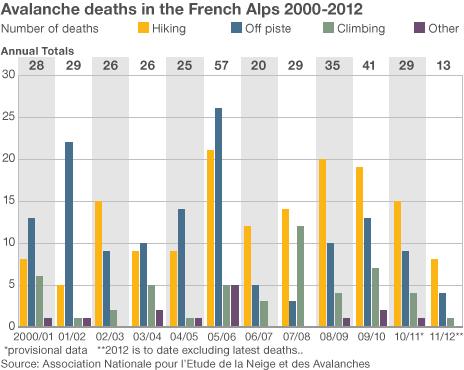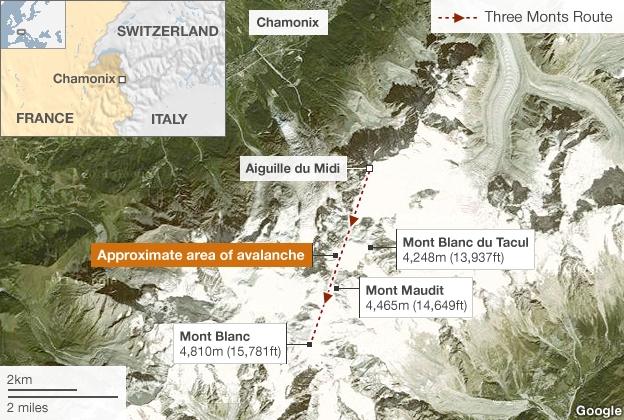Why risk an avalanche to climb?
- Published

Nine climbers died in the French Alps when they were swept away by an avalanche. The risk is well-known and was well understood by the experienced mountaineers who were killed. So what would lead someone to take that risk?
It is known as the Cursed Mountain. Standing at 4,465m (14,649ft) and covered in a treacherous carpet of snow and ice, Mont Maudit near Chamonix, is a challenge for the most intrepid climbers. It is one of the highest peaks in Europe.
But when the risks are so well known, why do people choose to take them?
"It's the wrong end of the stick to think we revel in near-death experiences," says mountaineer John Cousins, a climber with 35 years' experience.
"What I and lots of my counterparts enjoy, is managing risk. Adventure is about something being uncertain. Part of the challenge. Making judgements as you go along using your experience."
Since 2001, 358 peole have died in the French Alps. Cousins' friend Roger Payne, 55, was one of three Britons killed on Mont Maudit on Thursday. John Taylor, 48, and Steve Barber, 47, also perished.
Payne and Cousins had climbed together many times, from the mountains of North America to the tiny quarries of Lancashire.
The area has suffered avalanches before, external, but Cousins is keen to point out that it is not a black spot.
"If there is snow and an incline, there is a chance of an avalanche, if there is no snow and an incline you can get a rock fall. Anyone climbing should understand that there are risks, it is not really a question of black spots," he says.
Payne and his fellow climbers had set out in the early hours of Thursday, aiming to reach the summit of Mont Blanc by 6am before the heat of the day began to melt the snow.
The 28-strong group is believed to have reached 4,000m (13,120ft) when the avalanche struck at dawn.

Messner says he prays each time he climbs
"Mountains are dangerous places," says Reinhold Messner, one of the world's most famous mountaineers.
"I go to the mountains for an adventure and each time I pray I will get up and down again. The art of climbing is to go where you go knowing that you could die, but you don't die. That is adventure."
Messner is famous for repeatedly risking his life on astonishing climbs. He made the first solo ascent of Mount Everest without supplemental oxygen - a feat that had previously been thought impossible by doctors and fellow mountaineers.
He climbed his first 3,048m (10,000ft) peak at the age of five and quickly progressed to greater, more dangerous heights.
In 1970 he climbed the Rupal face of Nanga Parbat with his brother Gunther Messner. They reached the summit, but Gunther died two days later on the descent, external.
Reinhold himself lost six of his toes, which had become badly frostbitten during the climb and had to be amputated.
"People should know before they set off that mountains, all mountains, are dangerous," he adds.
"I go to the wild mountains where I am responsible for myself. Step by step I am making sure that I don't die. Climbing is an adventure, not a sport."

Avalanches can be caused by a variety of reasons. Compacted snow and ice can be caused to slip by fresh snow fall or strong winds. Vibrations or movement from skiers or climbers can also trigger a slide.
The results can vary according to the cause and the season. As Cousins explains, some winter avalanches have a powdery nature, the danger is that the climber is swamped rather than hit with force or swept away at speed.
Summer snow tends to be denser, the wider range of temperatures causes the snow to become more compacted.
"Tragically avalanches come in all shapes and sizes," he says.
The risks of mountain climbing are well known and widely discussed. As Cousins says, it is a test of strategy as much as phsyical endurance.
But does an awful shock of reality put climbers off?
"It doesn't put you off, people wonder why it doesn't, I have to admit," climber Alan Hinkes, another friend of Payne's, told the BBC.
"Probably for half a minute you think I don't know why I do it, but not for long. If you see a road traffic accident you don't give up driving. It's what we have do, we're just climbers, we can't help ourselves I guess."

- Published13 July 2012